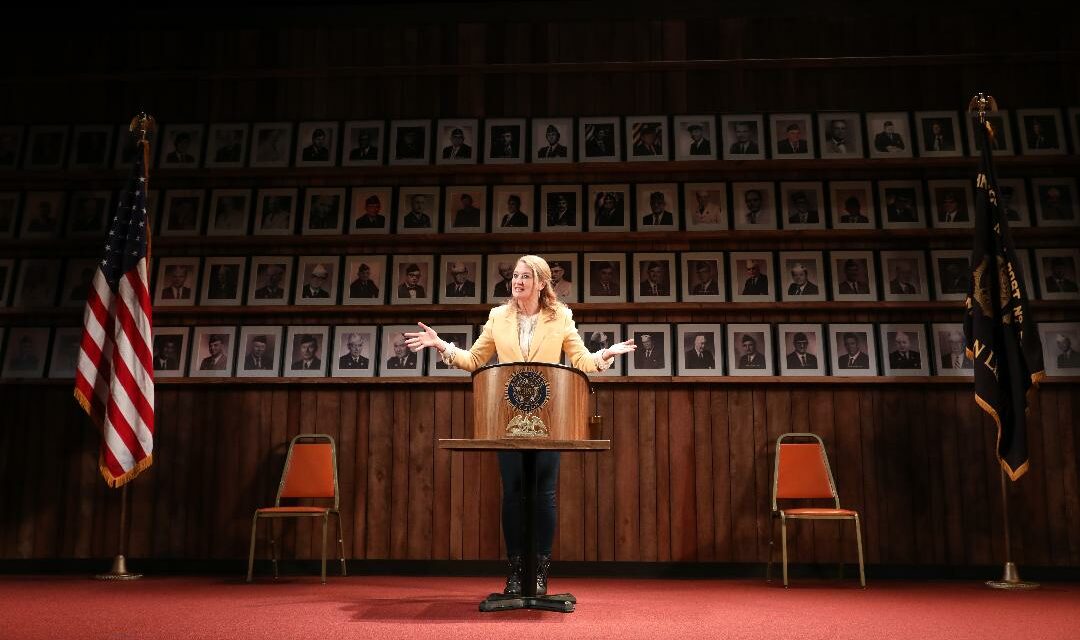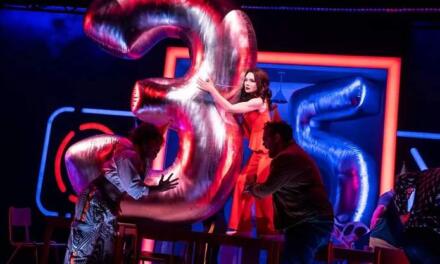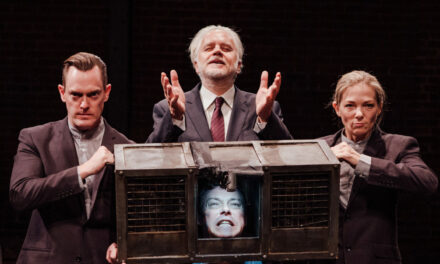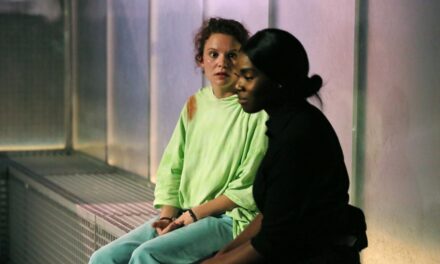“Man can change the world with bayonet and with science, but only art can renew it, in play, in illusion.”
– Otto F. Best
In March, after an extremely well-reviewed Off-Broadway run, Heidi Schreck’s play What The Constitution Means To Me will make its Broadway premiere in The Hayes Theatre. As this breathtakingly vulnerable and informative piece of autobiographical theatre moves to a larger stage and on to the radar of a larger New York theatre-going audience, it is crucial to look at why this play is so important in the current socio-political and artistic moment. The play is a (nearly) one-woman account of an adolescent––now Obie winning actress, television writer, and producer––Schreck’s participation in speech competitions on the United States Constitution in American Legion Halls across the country; a feat she undertook as a result of her mother being a high school debate coach. Schreck was so dominant that she was able to pay her entire college tuition with the money she won from the competitions.
The play, however, is not merely a tale of one young girl’s multiple successes in oratory competitions; though at first, it would be easy to mistake it as such. Constitution is an autobiographical piece that simultaneously interrogates both Schreck’s and the audience’s relationship to the United States Constitution. At the beginning of the performance, Schreck walks out with the house lights still up, and informally greets the audience: “Good evening. Thank you all for coming out tonight” (1). The intimate mid-sized NYTW house and Schreck’s personable presence immediately creates an informal and conversational environment. The stage is designed to look like any number of Legion Halls across the country––portraits of Veterans hung meticulously along every square inch of the wood-paneled wall behind her, a podium with the Legion’s logo, for her to stand and deliver from, and both the American flag and the Legion flag on either upstage side of the podium. A few minutes into the play, the lights go down. That’s when we find out that the entertainment for the evening has already started. It is at this point that Schreck, the author of What The Constitution Means To Me, transforms into the character of Heidi––the real adult woman who is here to tell us about her love for the United States Constitution [1]. Heidi is actually two characters––the adult and her fifteen-year-old self––but in switching between the two, Heidi informs the audience that she is “not going to do anything special to achieve that effect” (4). Later, a third character joins Heidi on stage, a middle-aged man in a full Legionnaire attire. He is never introduced, but he quickly takes charge of the competition. Backtracking a few steps, it is important to acknowledge that Schreck has also cast a fourth character––one who does not appear on the stage, but before it. Heidi tells the audience at one point that these competitions were held before a crowd of “older––mostly white––men” so for the purposes of the show, the audience is cast as those men. Heidi thanks the audience, and the story continues (3). The personal introduction to the play immediately dissolves the binary audience-performer conception of western theatre, setting Constitution in the same as the world of the audience—the real world. This invitation allows Schreck’s play to dissolve the imaginary division between the proscenium and the raked auditorium before it, asking the audience to think about what the Constitution means to them, too.
The play feels like a public forum on the issues of the Constitution. It hinges on the fifteen-year-old Heidi delivering her speech Casting Spells: The Crucible Of The Constitution and engaging in various “extemporaneous” debates on specific Constitutional amendments [2]. Periodically, present-day Heidi steps away from the world of her younger self for an aside––a modern thought on whatever part of the Constitution she is examining. It is in these asides that Schreck’s play reveals itself as more than just an autobiographical narrative about a young girl and her love for a document nearly as old as the country. Heidi incorporates Supreme Court cases, audio clips from real United States Supreme Court hearings, and personal stories of injustice, sexual abuse, and her family, all related to various amendments and clauses of the document.
The first of these addendums is Heidi’s mention of the Roe v. Wade case. The case, the landmark Supreme Court case concerning the legality of the termination of pregnancy and female reproductive rights in America, comes up when young Heidi completes the extemporaneous debate portion of the competition. She is given Amendment Fourteen: Section One and asked to deliver an overview of the entire section, followed by a two-minute speech for each of the clauses in the section. The Legionnaire is particularly strict with these time constraints during this portion of the show––I began to dislike that about him. Roe v. Wade comes into play when Heidi debates the third clause which reads: “Nor shall any State deprive any person of life, liberty, or property without due process of law” (US Const. amend. XIV, sec. 1). Young Heidi declares that this clause is at the core of the Roe v. Wade case, proceeds to outline why this is so––in a remarkably articulate fashion––and then states, “My view, which I feel obligated to share, even if it endangers my scholarship money, is that I support a woman’s right to choose. Although, it’s a choice I would never make personally” (16). Here, Heidi splits off from the fictional time of her two-minute speech, and the Legionnaire freezes accordingly. While Schreck says she actually said those words during the competition, she did not know at the time was that she would get pregnant a mere six years later. Heidi proceeds to share her struggle with the choice of what to do about her pregnancy. Following this, she plays an audio clip of Supreme Court Justices Potter Stewart and Earl Warren discussing the fate of birth control in the US. The recording is awkward; riddled with “uhh”s and coughs, it is evident that these men have no idea what they are talking about from a practical perspective in a very serio-comedic way. What’s more, Schreck makes a point to highlight that of the nine male justices, four of them were cheating on their wives at the time of this hearing. Schreck’s tactical placement of three different realities layered one upon another––that of her fifteen-year-old self, her twenty-one-year-old self, and the Supreme Court Justices––reveals the overarching reality of the flaws in the system that enforces and interprets Constitution.
Schreck’s ability to tactfully layer personal and political anecdotes to reveal thematic throughlines is the backbone and driving force of the play––ranging topically from abortion, to sexual assault, to domestic violence. Each time, young Heidi provides ample explication of the real text of the Constitution, present-day Heidi gives a deeply personal and always heartbreaking testimony of a related situation from her own life in the context of injustice and abuse present at the highest levels of government and legal institutions. Layering three (or sometimes more) different realities together into one piece of theatre illuminates the misuse/interpretation of the Constitution with the shared reality that Schreck creates by giving the theatre space a conversational setting from the first moment of the play. Her revelations challenge the effectiveness of the Constitutional structures presented to the audience, as they exist today. Schreck continues to do this throughout the remainder of the play by deconstructing many more realities. In the manner of a classic theatrical surprise, the Legionnaire de-costumes to reveal himself as Mike Iverson, a gay actor and friend of Schreck now wearing a green Amoeba Records t-shirt. He says he was playing a real person, Mel Yonkin, a legionnaire who actually traveled with and supported Schreck and her family when she was competing as a young girl. He proceeds to tell us an abridged version of his life story in a stream of consciousness manner, then sits back down to continue the rest of the play. Later, Schreck brings on a very young woman of color from a local New York middle school debate team named Rosdely Ciprian. Rosdely assists Schreck––far better than I or any of my peers could, I must say––in one of the aforementioned “extemporaneous” debates. The prompt: to keep or not to keep the Constitution––is ironic given that in the eyes of the Constitution, a female child of color is the most marginalized combination of intersectionality, as people of color and women were not given the right to vote in the United States until 1870 [3] and 1920, respectively, and children still do not have the right to vote. After the two powerful minds presented their cases, Schreck turns to the audience and asks them to decide the winner of the debate. In doing so, yet another reality––an imaginary one where those in the audience hold the fate of the US Constitution in their hands––is created.
All of these realities are not only presented to the audiences but actively interact with the goings on of the world beyond the theatre. The particular evening I saw Constitution was Saturday, September 29th two days after Dr. Christine Blasey Ford appeared before the Senate Judiciary Committee to testify that Supreme Court then-Nominee, now (in)Justice, Brett Kavanaugh, had sexually assaulted her at a party when they were in high school. The proceedings of the hearing were messy and partisan, and despite Dr. Ford’s compelling and emotional testimony––in which afterwards she and her integrity were repeatedly speared by Republican members of the committee––and an FBI investigation, Kavanaugh was appointed to the Supreme Court. In the wake of this controversy, Schreck’s piece became about the power of Constitution and those who interpret it in the present moment; on that night. Despite Constitution having been written over the course of the past ten years, it seemed as though it was written that morning, for our specific audience, aimed at the specific political moment of not just the recent few months or weeks, but that day. Herein lies the crux of the play’s power: Schreck has engineered her piece to touch on the parts of the US Constitution that are most violated and misrepresented in our legislative system today. Schreck’s specific focus on the injustices and abuse––sexual and otherwise––that both she and the women of her family have endured is not innately related to any particular political moment. Schreck’s inclusion of these issues shows that her critical analysis of both the US Constitution and political patterns of the early twenty-first century yields an understanding of what the current issues are, thus allowing her to pitch the play’s relevance to modern political climates. While the particular performance I saw was relevant to the Kavanaugh controversy, there have been no shortage of political dumpster-fires that connect to the piece in the remainder of its run [4]. An interview with Schreck in Salon touches on the play’s relevance to President Trump’s threatening of the “right to be a citizen upon birth” given the play’s primary focus on Amendment Fourteen, in which the right is guaranteed (Marcotte). Numerous connections between the play and various current political moments are drawn, illustrating the mastery with which Schreck has developed and transplanted her understanding of the Real [5] of today into the piece––despite being an artwork a decade in the making.
This play is deeply dependent on the presentation, representation, and reconstruction of reality. There are often too many layers of the real life of Heidi Schreck woven into the piece to fully articulate: the original reality of a fifteen-year-old girl competing in speech competitions; the reality of the future that girl thought she understood; the reality of what that future actually held for a young Heidi; the reality of What The Constitution Means To Me being written about all of those previous realities; the reality of Heidi Schreck performing her story on the NYTW stage; and the reality of the audience being invited to participate in the experience with her––all of which actively comment on and interact, both intentionally and coincidentally, with the reality of the current political moment. Presently, Constitution is too recent to measure any mass-quantifiable socio-political change that may occur as a result of the production––Brett Kavanaugh was still appointed to the Supreme Court, the Fourteenth Amendment rights of millions of first-generation Americans are still in jeopardy, and Donald Trump is still President of the United States. This being said, change exists without being able to be measured in mass.
Following the performance of What The Constitution Means To Me that I attended, audience members were handed pocket editions of the United States Constitution courtesy of the American Civil Liberties Union as the president of the ACLU, Dr. Susan N. Herman, would be present at a talkback that evening. Following that performance, these tiny blue books would be offered at the end of every performance of Constitution for the remainder of its run. I’ve since read through the book and aim to continue to grow my own civic literacy; to learn what our rights are and how to protect them when they are under attack by the powers that be. Many of my colleagues who also saw the show have expressed their similar intentions. So, that tallies to at least a dozen people who have been changed by Schreck’s play––sounds quantifiable to me. Vegas odds say that out of the thousands of people who have now seen or will see the play in the remainder of its run, more people will share the conviction to learn more about their rights as Americans. That is change. It may only be on a micro scale, but in her closing argument for the preservation of the Constitution, Rosdely herself proclaimed: “If you want to change the country, go change the hearts and minds of people, not a piece of paper. Run for local office, run for student government. Start with your own personal constitution and build your way out. No one’s gonna save us. We have to save ourselves” (47).
Given the tumultuous state of the current American political state, the impact of a piece of theatre like What the Constitution Means to Me has the potential to change every night. A piece tied so closely to both politics and humanity––which so often seem to be on opposing sides––illuminates what the duty of activism the audience has in coming to the theatre, and how said duty must be carried out the doors with them instead of under the seat with forgotten playbills. What The Constitution Means To Me’s Off-Broadway run closed in December 2018, but was consequently announced to have a twelve-week limited engagement in The Hayes Theatre on Broadway. The same cast will return on the new stage. Previews begin March 14th.
Notes
- All these different iterations of Heidi Schreck may get confusing. For the sake of clarity here, I will reference Heidi Schreck as the writer of the play by using her last name, but Heidi Schreck as we see her on the stage by her first. I find this important to distinguish as there are multiple layers of representation and orchestration going on throughout the play, so I would like to refer to them as such instead of grouping them all as one. If for nothing else, it would be to clarify what Heidi Schreck is doing while literally on stage versus what Heidi Schreck is meta-doing in creating Constitution.
- The format of these debates at the American Legion competitions was extemporaneous, but all of the debating done through the course of the play is entirely scripted––in and of itself a representation of the actual reality of Heidi’s childhood.
- Not to ignore the protection of voting rights for people of color with the Voting Rights Act of 1965, nor the continual disenfranchisement of millions of Americans in Puerto Rico, Guam, and the mainland United States due to laws that target minority groups or falsified holds on voter registration predominantly applying to people of color living in the south like the scandal surrounding Georgia Governor, Brian Kemp (Reaney).
- Voter registration restriction, midterm elections, government shutdowns, and birthright citizenship to name just a selection of them. The list goes on, but I don’t particularly want to address all of them at the moment for the sake of sanity; yours and mine, alike.
- Real with a capital-R refers to when the reality of the world beyond the theatrical stage works its way on to it, often through styles of theatre like verbatim or documentary theatre, or fictional theatre with extra-textual elements and signifiers of the Real; from Carol Martin’s theory and Book, Theatre Of The Real (Martin).
Works Cited
- Best, Otto F.. Peter Weiss. New York: F. Ungar Pub. Co., 1976. Print.
- Marcotte, Amanda. “We Treat the Constitution Like a Religious Text, with Women’s Bodies on the Line.” Salon November 14, 2018. Web. Dec 16, 2018.
- Martin, Carol. Theatre of the Real. Ed. SpringerLink. London: Palgrave Macmillan UK: Imprint: Palgrave Macmillan, 2013. Web.
- Reaney, Olivia. “The Evolution of American Voting Rights in 242 Years shows how Far we’ve Come — and how Far we Still have to Go.” Business Insider November 6, 2018Web. Dec 16, 2018.
- Schreck, Heidi. What the Constitution Means to Me: Draft-in-Progress., 2018. Web.
- U.S. Constitution. Amend. XIV, Sec. 1.
This post was written by the author in their personal capacity.The opinions expressed in this article are the author’s own and do not reflect the view of The Theatre Times, their staff or collaborators.
This post was written by Lucas M. Kernan.
The views expressed here belong to the author and do not necessarily reflect our views and opinions.


















